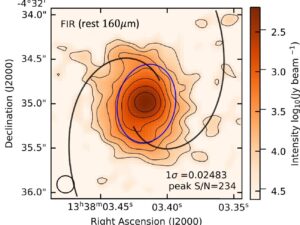
One of the things I love about astronomy is there is always something weird and rare waiting to be discovered.
Recently, the Atacama Large Sub-millimeter and Millimeter Array looked at a galaxy twelve billion light years away. Looking directly at the data, if you squint and tilt your head, you can make out a spiral pattern. Luckily, software has the ability to look at more colors, integrate motions, and piece together subtle features our brains often overlook.
Putting all the pieces together, the spiral structure of the galaxy emerges.
This system, cataloged as BRI 1335-0417, is the most distant known spiral galaxy.
Analysis of this data is published in the Monthly Notices of the Royal Astronomical Society with first author Takafumi Tsukui.
According to Tsukui, “We were interested in how gas was moving into and throughout the galaxy. Gas is a key ingredient for forming stars and can give us important clues about how a galaxy is actually fuelling its star formation.”

The team found the gas in this spiral is largely flattened with a bar in the center, but there are also unusual vertical oscillations. According to Tsukui, “The vertically oscillating motion of the disk is due to an external source, either from new gas streaming into the galaxy or by coming into contact with other smaller galaxies – Both possibilities would bombard the galaxy with new fuel for star formation.”
Bombard the galaxy and set up cool waves that show up in a millimeter array.
Spiral structures are rare in the early universe, and the more we find, the more chances we’ll have to piece together exactly what’s going on. This data set is just one amazing snapshot in the galaxy’s many billion-year life, but this baby shot, while not very cute, is super informative.
